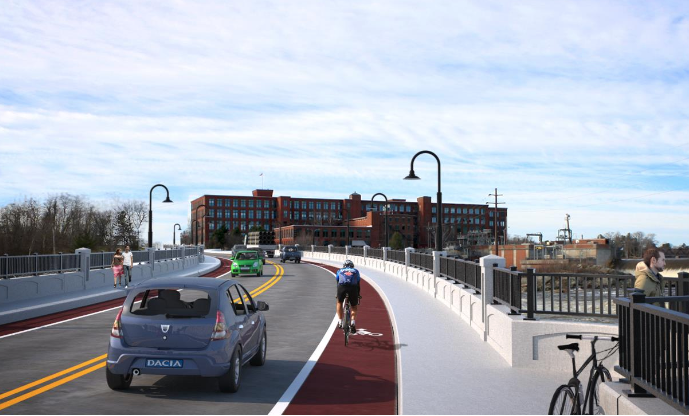BRUNSWICK — Town Council got a good look at the potential replacement of the Frank J. Wood Bridge, which connects Brunswick and Topsham.
If the aging bridge is replaced rather than restored, the Brunswick-Topsham Bridge Advisory Committee is prepared to make extensive design recommendations to the Maine Department of Transportation, which is still deciding whether or not to replace the existing bridge.
Committee Vice-Chair Michael Lyne pointed out that a final decision on replacement vs. restoration is out of the committee’s hands. “It’s purely advisory if the MDOT decides the bridge needs to be replaced,” said Lyne of the committee’s work.
The committee has been working on the design of the bridge for the past 15 months, refining the original design to emphasize both the historical aspects of the area and pay homage to the bridge that came before it. If MDOT decides to move forward with replacement, the project is estimated to cost $13 million and begin in 2019.
“We really — as we started to peel this back — wanted to focus on the site itself, which may sometimes get lost in translation over that bridge today,” said Lyne.
That effort includes having architectural cues, such as arched designs on the exterior walls, and perhaps the creation of small informational displays located at the current bridge’s foundation. Those displays would harken back to the history of the area, including references to past bridges over the Androscoggin River. By most estimations, the new bridge would be the seventh structure to cross Pejepscot Falls.
The committee has also been inviting anyone from the community with interests in the future bridge to speak at their meetings. Everyone from fire departments to local bicycle and pedestrian groups have given their thoughts on the structure.
Key aspects of the bridge include five-foot shoulders on either side of the travel lanes to allow for bicycle traffic across the bridge. Bicycle lanes would be painted red, in the hopes of keeping traffic slow on the span.
Keeping traffic speeds slow is a key goal of the committee, said Committee Chair Bruce Van Note. “Our target was as low as you can make it through there,” he said.
Elements like painted bicycle lanes, crosswalks at the beginning and end of the span, and extensive sidewalks are part of making sure the bridge serves as an extension of the two main streets. “We’re hoping that it gives the idea that this isn’t a through-way, this is part of a place,” Van Note said.
Some councilors were skeptical that the new bridge would slow down traffic. Counicilor Steve Walker said, “You have not convinced me that the big wide-open bridge would contribute to slower speeds than we have now.”
But despite some speed concerns, Council Chair Alison Harris said she feels the new bridge will emphasize the beauty of the location. “The thing I find the most meaningful is opening up the vistas,” she said.
MDOT does not yet have a scheduled date on when the decision will be made regarding the future of the Frank J. Wood Bridge.
Comments are not available on this story.
Send questions/comments to the editors.


